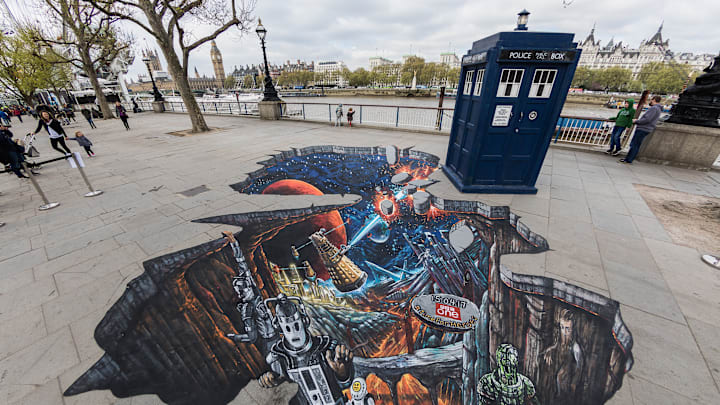1963: Doctor Who premieres

William Hartnell Years (1963-1966)
On November 23, 1963, Doctor Who premiered. However, it was delayed and poorly viewed because of the assassination of John F. Kennedy the day before. Despite this decidedly inauspicious start, the show took off after its next serial "The Daleks" aired.
People loved the Daleks, so much so that the early period of Doctor Who's success became known as "Dalekmania." While the early years of the show had an emphasis on education, complete with mini lectures on history and science, many fans were enchanted by the classic battles between good and evil.
Over time, the Doctor became less grumpy and critical, coming to view his companions with fondness. This only made viewers love him more. However, William Hartnell developed health complications due to arteriosclerosis which made it difficult for him to continue in the role. It seemed like Doctor Who might just end in 1966.

Patrick Troughton Years (1966-1969)
One of the best ideas to ever come to Doctor Who was the invention of regeneration. The BBC had decided to replace William Hartnell, but fans often struggle to accept another actor taking the lead. Producer Innes Lloyd and story editor Gerry Davis decided that the Doctor's alien nature could explain the change, in a move they called "renewal."
The change happened during the serial "The Tenth Planet," which also introduced the iconic Cybermen. While Troughton was accepted as the Doctor, ratings were dropping. Along with them, the budget for the show fell.
To save costs, they decided that the Doctor needed to be kept in one place and time for a while. Who could control the Doctor but his own people, who he'd been on the run from? Thus began the lore of the Time Lords and Gallifrey.
Producer Derrick Sherwin and writer Terrance Dicks share the credit for this invention. In the serial "The War Games," the Doctor calls on the Time Lords to help return stolen soldiers to their homes. They put him on trial and sentence him to forced regeneration and exile on Earth, without the ability to travel in space or time.
While this was an era founded by necessity, it was also one of invention, where the foundational lore of the series was established.

Jon Pertwee Years (1970-1974)
The Third Doctor's run was very different from the ones that came before it, but those restrictions brought out more innovation. To begin with, the Doctor was stuck on Earth. This gave him the opportunity to see Earth as a home, rather than a preferred vacation spot.
A major element of this was his job working as a scientific advisor for the United Nations Intelligence Taskforce (later called the Unified Intelligence Taskforce). While UNIT was introduced during Patrick Troughton's era, the organization was critical to the third Doctor's run.
In order to keep stakes up, despite having a limited budget, Doctor Who introduced an archenemy for the Doctor: The Master. Introduced in "Terror of the Autons," he was described as "a longstanding and implacable enemy of the Doctor, he is the force of evil bound to oppose the Doctor's force of good."
Played masterfully by Roger Delgado, the Master was terrifying and intriguing. However, even he couldn't quite overcome the trouble of having a show about space and time travel trapped in one time and place. Thus, for the series's tenth anniversary, the special "The Three Doctors" allowed the Doctor to travel freely once more.
Other notable changes during this period include:
- The series being filmed and aired in color, rather than black and white
- The transition between the Third and Fourth Doctors features the first use of the word "regeneration"
